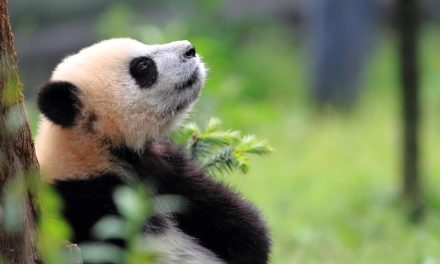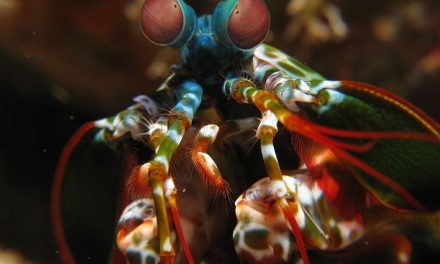
Despite their exalted status and relative lack of natural predators, pandas are still at risk. Severe threats from humans have left only about 1,800 pandas in the wild. ©Brad Josephs
Because of ongoing and potential loss of their sea ice habitat resulting from climate change, polar bears were listed as a threatened species in the United States under the Endangered Species Act in May 2008. Ursus maritimus soon became the poster child for a warming planet; and since that time, images of polar bears have graced water bottles, T-shirts and tote bags.
Today, polar bears are categorized as “vulnerable” by the International Union for Conservation of Nature (IUCN), and World Wildlife Fund (WWF) estimates that there are between 22,000 and 31,000 of the bears left in the wild. Scientists have divided the total polar bear population into 19 subpopulations. Of those, the latest data from the IUCN Polar Bear Specialist Group shows that three units are in decline, and that there is a high risk of decreasing numbers in the future due to climate change.
We know of other species in great peril—mostly because of the media attention they attract. In November 2010, the International Tiger Forum was held in St. Petersburg in the Russian Federation. As the world’s first global summit focused on saving a single species from extinction, the event received widespread news coverage. Every year since 2010, July 29 has been recognized as International Tiger Day (or Global Tiger Day), in order to raise public awareness and support for tiger conservation issues.

Tigers face pressures from poaching, retaliatory killings and habitat loss. They are forced to compete for space with dense and growing human populations. ©Drew Hamilton
Because their likenesses often spearhead conservation campaigns, chances are that even if you don’t live in polar bear or tiger habitats—where it would be at least possible for you to run into them during your daily life—you will miss them when they disappear from our world. You will definitely notice the loss.
But will you mourn the extinction of other species living today if you’ve never heard of them nor seen them?
The ones you know
World Wildlife Fund estimates that there are less than 2,000 mature, wild giant pandas left in the wild today. They live in central China, in bamboo thickets and in the coniferous forests in the high mountains. In 1961, the organization made this animal its symbol. Today, the trademark black-and-white bear with the “WWF” text is probably the most recognized, universal logo for the conservation movement itself.

WWF states that there is a high estimated risk of polar bear numbers declining in the future due to climate change. Because of that, the protection of the bears’ habitat is an urgent issue for the organization.
And if you grew up before the 1980s, frogs most likely played some part in your childhood. We heard them croak down by the rivers, saw them jump away from us on our explorations of neighboring woods and recognized the ribbet that emanated from the longer grass in our lawns. Perhaps, you and your elementary classmates even kept one in a school terrarium. But something strange started happening several decades ago. They began to disappear all over the world.
No one knows exactly why.
The ones you don’t
But just as surely as we’re losing frogs and pandas, we’re losing our vaquitas, a small porpoise endemic to Mexico’s Sea of Cortez. Vaquitas are the world’s tiniest and most endangered marine cetacean. WWF states that there are only about 30 individuals left in the world. Trawl and gill nets used in both hobby and commercial fishing have devastated vaquita numbers. Added to that threat is their habitat degradation caused by the damming of the Colorado River. Today, vaquitas face almost imminent extinction.
Habitat loss is also contributing to the demise of the bonobo, a chimpanzee-like ape found only in the Congo Basin rain forests of the central Democratic Republic of the Congo. Their numbers, estimated to be between 10,000 and 50,000, are declining further because of bush-meat hunters. Some say we’ll soon lose the last individuals of a species that could be our closest relatives. Bonobos exhibit remarkably different social behavior than chimpanzees. Unlike the combative chimps, their social interactions emphasize peacemaking; a trait in the animal kingdom that is rare and from which we humans could learn a lot.

The vaquita, the world’s most rare marine mammal, is on the verge of extinction. ©Paula Olson, NOAA
If tomorrow you were to find out that the world’s vaquitas and bonobos were gone, would you feel their loss as much as you would the disappearance of polar bears, tigers, giant pandas or frogs? Can you miss a species that you never knew? After all, how much do you really miss the dodo or the passenger pigeon?
It’s an alluring question to ask ourselves, I think. Personally, I hope my answer would be that I’d miss them, all the same.
What’s your response?
Here’s to finding your true places and natural habitats,
Candy



































We will certainly miss the ones we are familiar with, and the ones that are relatively unknown, we will support their right to life, knowing that many of them, if not all, in some way, contribute to the diversity and beauty of earth’s animal kingdom.
Every species is important-and each one is worth getting to know through reading. The more we understand, the more we value-at least this has been true for many.
Educating on the Endangered Species has been a valuable tool in conservation efforts…I hope this continues to be the case for changing all of our futures.
All wildlife is precious, whether iconic species or less so. Each have a role to play in our world.